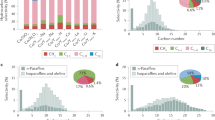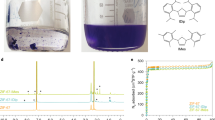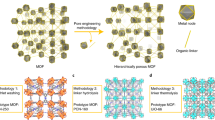Abstract
The assembly of molecular building blocks with metal ions genera-ting microporous network solids has been the focus of intense activity1,2,3,4,5,6,7,8,9,10,11,12. Because of their potential applications associated with channels and cavities, such materials have been examined for size- and shape-selective catalysis, separations, sensors, molecular recognition and nanoscale reactors. Within this context, assemblies of robust and chemically versatile porphyrin and metalloporphyrin building blocks remain rare. Supramolecular architectures of porphyrin solids based on weak van der Waals interactions13,14, hydrogen bonding15,16 and metal-ligand coordination networks17,18,19,20,21,22,23 have been reported. Although there are frequent allusions to zeolite-like microporosity from crystallography and loss of initial guest solvent molecules, evidence of functional microporous behaviour is scarce. We have demonstrated repeatable sorption–desorption with high selectivity on the basis of size, shape and functional group of the sorbate by a microporous metalloporphyrin solid in analogy to zeolites.
This is a preview of subscription content, access via your institution
Access options
Subscribe to this journal
Receive 12 print issues and online access
$259.00 per year
only $21.58 per issue
Buy this article
- Purchase on Springer Link
- Instant access to full article PDF
Prices may be subject to local taxes which are calculated during checkout



Similar content being viewed by others
References
Pinnavaia, T.J. & Thorpe, M.F. Access in Nanoporous Materials (ed. Thorpe, M.F.) (Plenum, New York, 1995).
Yaghi, O.M., Li, G. & Li, H. Selective binding and removal of guests in a microporous metal-organic framework. Nature 378, 703–706 (1995).
Janiak, C. Functional organic analogues of zeolites based on metal-organic coordination frameworks. Angew. Chem. Int. Edn Engl. 36, 1431–1434 (1997).
Russell, V., Evans, C.C., Li, W. & Ward, M.D. Nanoporous molecular sandwiches: pillared two-dimensional hydrogen-bonded networks with adjustable porosity. Science 276, 575–579 (1997).
Kitagawa, S. & Kondo, M. Functional micropore chemistry of crystalline metal complex-assembled compounds. Bull. Chem. Soc. Jpn 71, 1739–1753 (1998).
Aoyama, Y. Functional organic zeolite analogues. Top. Curr. Chem. 198, 132–161 (1998).
Cheetham, A.K., Ferey, G. & Loiseau, T. Open-framework inorganic materials. Angew. Chem. Int. Edn Engl. 38, 3268–3292 (1999).
Barton, T.J. et al. Tailored porous materials. Chem. Mater. 11, 2633–2656 (1999).
Chui, S.S.-Y., Lo, S.M.-F., Charmant, J.P.H., Orpen, G.A. & Williams, I.D. A chemically functionalizable nanoporous material [Cu3(TMA)2(H2O)3]. Science 283, 1148–1150 (1999).
Li, H., Eddaoudi, M., O'Keefe, M. & Yaghi, O.M. Design and synthesis of an exceptionally stable and highly porous metal-organic framework. Nature 402, 276–279 (1999).
Seo, J.S. et al. A homochiral metal-organic material for enantioselective separation and catalysis. Nature 404, 982–986 (2000).
Chen, B., Eddaoudi, M., Hyde, S.T., O'Keeffe, M. & Yaghi, O.M. Interwoven metal-organic framework on a periodic minimal surface with extra-large pores. Science 291, 1021–1023 (2001).
Byrn, M.P., Curtis, C.J., Khan, S.I., Sawin, P.A., Tsurumi, R. & Strouse, C.E. Tetraarylporphyrin sponges. Composition, structural systematics and applications of a large class of programmable lattice clatharates. J. Am. Chem. Soc. 112, 1865–1874 (1990).
Krupitsky, H., Stein, Z. & Goldberg, I. Structural patterns in clathrates and crystalline complexes of zinc-tetra(4-chlorophenyl)porphyrin and zinc-tetra(4-fluorophenyl)porphyrin. J. Inclus. Phenom. Mol. 20, 211–232 (1995).
Bhyrappa, P., Wilson, S.R. & Suslick, K.S. Hydrogen-bonded porphyrinic solids: supramolecular networks of octahydroxy porphyrins. J. Am. Chem. Soc. 119, 8492–8502 (1997).
Bhyrappa, P. & Suslick, K.S. Supramolecular networks of octahydroxy porphyrins. Supramol. Chem. 9, 169–174 1998).
Abrahams, B.F., Hoskins, B.F., Michall, D.M. & Robson, R. Assembly of porphyrin building blocks into network structures with large channels. Nature 369, 727–729 (1994).
Hagrman, D., Hagrman, P.J. & Zubieta, J. Solid-state coordination chemistry: the self-assembly of microporous organic-inorganic frameworks constructed from tetrapyridylporphyrin and bimetallic oxide chains or oxide clusters. Angew. Chem. Int. Edn Engl. 38, 3065–3168 (1999).
Pan, L., Noll, B.C. & Wang, X. Self-assembly of free-base tetrapyridylporphyrin units by metal ion coordination. Chem. Commun. 157–158 (1999).
Diskin-Posner, Y., Dahal, S. & Goldberg, I. New effective synthons for supramolecular self-assembly of meso-carboxylphenylporphyrins. Chem. Commun. 585–586 (2000).
Lin, K.J. SMTP-a: the first functionalized metalloporphyrin molecular sieves with large channels. Angew. Chem. Int. Edn Engl. 38, 2730–32 (1999).
Sharma, C.V.K. et al. Design strategies for solid-state supramolecular arrays containing both mixed-metalated and freebase porphyrins. J. Am. Chem. Soc. 121, 1137–1144 (1999).
Kosal, M.E. & Suslick, K.S. Microporous porphyrin and metalloporphyrin materials. J. Solid State Chem. 152, 87–98 (2000).
Suslick, K.S. & Van Deusen-Jeffries, S. in Comprehensive Supramolecular Chemistry (ed. Suslick, K.S.) 1–30 (Elsevier, Oxford, 1996).
Catterick, J., Hursthouse, M.B., New, D.B. & Thorton, P.J. X-ray crystal structure and magnetic properties of a trinuclear cobalt(II) carboxylate. Chem. Commun. 843–844 (1974).
Rardin, R.L. et al. Synthesis and characterization of the linear trinuclear complexes [M3II(O2CCH3)6(biphme)2], M = Mn, Fe. Angew. Chem. 29, 812–814 (1990).
Connolly, M.L. Computation of molecular volume. J. Am. Chem. Soc. 107, 1118–1124 (1985).
Voorintholt, R., Kosters, M.T., Vegter, G., Vriend, G. & Hol, W.G.J. A very fast program for visualizing protein surfaces, channels and cavities. J. Mol. Graph. 7, 243–245 (1989).
Breck, D.W. Zeolite Molecular Sieves (Robert E. Krieger, Malabar, 1984).
Szostak, R. Molecular Sieves (Blackie, London, 1998).
Acknowledgements
We thank Jim Lenke and Jan Nimrick of the UIUC School of Chemical Sciences Microanalysis Laboratory for assistance with TGA, and Theresa Prussak for assistance in obtaining single-crystal X-ray diffraction data. This work has been supported in part by the US National Institutes of Health, and in part by the US Department of Energy, Division of Materials Sciences through the Frederick Seitz Materials Research Laboratory at the University of Illinois at Urbana-Champaign.
Author information
Authors and Affiliations
Corresponding author
Ethics declarations
Competing interests
The authors declare no competing financial interests.
Supplementary information
Rights and permissions
About this article
Cite this article
Kosal, M., Chou, JH., Wilson, S. et al. A functional zeolite analogue assembled from metalloporphyrins. Nature Mater 1, 118–121 (2002). https://doi.org/10.1038/nmat730
Received:
Accepted:
Published:
Issue Date:
DOI: https://doi.org/10.1038/nmat730
This article is cited by
-
Novel Self-assembly Coordination Lipid Polymers that Fold into Toroids with DNA-Delivery Potential
Journal of Inorganic and Organometallic Polymers and Materials (2021)
-
Zinc-orotate coordination polymer: synthesis, thermogravimetric analysis and luminescence properties
SN Applied Sciences (2020)
-
Reticular chemistry in electrochemical carbon dioxide reduction
Science China Materials (2020)
-
A critical review on recent developments in MOF adsorbents for the elimination of toxic heavy metals from aqueous solutions
Environmental Science and Pollution Research (2020)
-
Formation of organometallic microstructures via self-assembling of carboxylated zinc phthalocyanines with selective adsorption and visible light-driven photodegradation of cationic dyes
Journal of Materials Science (2018)



